Switzerland: Jungfraujoch
Feb 15, 2021 16:18:20 #
The Jungfraujoch (German: lit. "Jungfrau saddle") is a saddle connecting two major 4000ers of the Bernese Alps: the Jungfrau and the Mönch. It lies at an elevation of 3,463 metres (11,362 ft) above sea level and is directly overlooked by the rocky prominence of the Sphinx. The Jungfraujoch is a glacier saddle, on the upper snows of the Aletsch Glacier, and part of the Jungfrau-Aletsch area, situated on the boundary between the cantons of Bern and Valais, halfway between Interlaken and Fiesch.
Since 1912, the Jungfraujoch has been accessible to tourists by the Jungfrau line, a railway from Interlaken and Kleine Scheidegg, running partly underground through a tunnel through the Eiger and Mönch. The Jungfraujoch railway station, at an elevation of 3,454 metres (11,332 ft) is the highest in Europe. It lies east of the saddle, below the Sphinx station, and is connected to the Top of Europe building, which includes several panoramic restaurants, shops, exhibitions, and a post office. Several tunnels lead outside, where secured hiking trails on the crevassed glacier can be followed, in particular to the Mönchsjoch Hut. The normal route to the Jungfrau and Mönch starts from there.
The Sphinx Observatory, one of the highest astronomical observatories in the world, provides an additional viewing platform at a height of 3,572 metres (11,719 ft), the second-highest in Switzerland. It can be reached by an elevator from the Jungfraujoch. The observatory houses one of the Global Atmosphere Watch's atmospheric research stations. The Jungfraujoch radio relay station, which is not accessible to the public, is installed west of the Jungfraujoch, on the Jungfrau ridge. It is Europe's highest radio relay station.
The name Jungfrau ("maiden, virgin"), which refers to the highest mountain overlooking the Jungfraujoch, is most likely derived from the name Jungfrauenberg given to Wengernalp, so named for the nuns of Interlaken Monastery, its historical owner. However, the "virgin" peak was heavily romanticized as "goddess" or "priestess" only in late 18th to 19th century Romanticism. After the first ascent in 1811 by Swiss alpinist Johann Rudolf Meyer, the peak was jokingly referred to as "Mme Meyer" (Mrs. Meyer).
The Jungfraujoch is the lowest point (key col) between the Jungfrau and the Mönch. The south side (canton of Valais), almost flat, is constituted by the Jungfraufirn, one of the branches of the Aletsch Glacier, the longest in the Alps. From the south, the Jungfraujoch can be relatively easily accessed by mountaineers in two days from the region of Fiesch, via the Konkordia Hut. The north side (canton of Bern) is almost vertical with a difference of height of nearly 3,000 metres from the bottom of the valley at Interlaken, with no easy natural access. For those reasons, the only easy and quick access to the Jungfraujoch is through the 7 kilometre-long tunnel of the Jungfrau Railway, accessed via Kleine Scheidegg on the north side, the railway pass between Lauterbrunnen and Grindelwald.
Administrativelly, the Jungfraujoch is split between the territories of the municipalities of Lauterbrunnen and Fieschertal. The ridge between the Jungfrau and the Mönch is a major European watershed as well. The north side is drained by the Weisse Lütschine, the Aare and the Rhine. The south side is drained by the Massa and the Rhone.
Adolf Guyer-Zeller first thought of the idea of a tunnel in 1893, and at that point, he had planned to have seven stations inside the tunnel before reaching the peak of the Sphinx. The building of the tunnel started on July 27, 1896 and took 16 years to complete. The construction phase was troubled by many problems including monetary shortages, inclement weather and mounting deaths due to construction accidents. The worst accident occurred in 1908, when 30 tons of dynamite accidentally exploded.
When construction finally finished, the railway reached only to the height of the Jungfraujoch saddle, rather than the summit of the Sphinx, and had only two intermediate stations. However, even in its current state, the Jungfraubahn is a significant achievement in engineering and construction, still holding the title for highest railway in Europe.
The train into the mountain leaves from Kleine Scheidegg, which can be reached by trains from Grindelwald and Lauterbrunnen. The train enters the tunnel running eastward through the Eiger shortly after leaving Kleine Scheidegg.
It runs close behind the Eiger's north face, stopping at Eigerwand, where there is a window about 8 m long and a metre high, halfway up the face. The windows have been placed in holes used to remove excavated rock from the tunnel during construction, and are also occasionally used as access points, by climbers, and also rescue parties. This window was used for one of the final scenes of a Clint Eastwood spy movie, The Eiger Sanction. There one can get off the train to admire the view before the train continues five minutes later. The tunnel then turns west, heading towards the Jungfrau. There is a second stop at a window looking out on the Eismeer ("Sea of Ice") before the train continues to the Jungfraujoch. The tunnel was constructed between 1898 and 1912; it is about 7 kilometers (4.3 mi) long, with gradients of up to 25%. The journey from Kleine Scheidegg to Jungfraujoch takes approximately 50 minutes including the stops at Eigerwand and Eismeer; the downhill return journey taking only 35 minutes.
https://en.wikipedia.org/wiki/Jungfraujoch
NEW FROM 2020: With the opening of the "Eiger Express" on 5 December 2020, the Jungfrau Railways' V-Bahn project was completed, enabling the journey from Interlaken to the Jungfraujoch in just one and a half hours. From the terminal in Grindelwald, a 3S cableway takes you directly to the station Eigergletscher (Eiger Glacier) in 15 minutes. Once at the top, there is even more time to enjoy the panorama and the adventure world.
https://www.myswitzerland.com/en-us/destinations/jungfraujoch/
We traveled from our hotel in Interlaken to the railway station in Grund (Grindelwald) and took the train to Kleine Sheidegg where we boarded the cog railway Jungfraubahn train which traveled through the tunnel to the Jungfroujoch. I hope you enjoy the next few posts of images taken from the train, at stops along the way and from visitors center at the top.
Mark
Since 1912, the Jungfraujoch has been accessible to tourists by the Jungfrau line, a railway from Interlaken and Kleine Scheidegg, running partly underground through a tunnel through the Eiger and Mönch. The Jungfraujoch railway station, at an elevation of 3,454 metres (11,332 ft) is the highest in Europe. It lies east of the saddle, below the Sphinx station, and is connected to the Top of Europe building, which includes several panoramic restaurants, shops, exhibitions, and a post office. Several tunnels lead outside, where secured hiking trails on the crevassed glacier can be followed, in particular to the Mönchsjoch Hut. The normal route to the Jungfrau and Mönch starts from there.
The Sphinx Observatory, one of the highest astronomical observatories in the world, provides an additional viewing platform at a height of 3,572 metres (11,719 ft), the second-highest in Switzerland. It can be reached by an elevator from the Jungfraujoch. The observatory houses one of the Global Atmosphere Watch's atmospheric research stations. The Jungfraujoch radio relay station, which is not accessible to the public, is installed west of the Jungfraujoch, on the Jungfrau ridge. It is Europe's highest radio relay station.
The name Jungfrau ("maiden, virgin"), which refers to the highest mountain overlooking the Jungfraujoch, is most likely derived from the name Jungfrauenberg given to Wengernalp, so named for the nuns of Interlaken Monastery, its historical owner. However, the "virgin" peak was heavily romanticized as "goddess" or "priestess" only in late 18th to 19th century Romanticism. After the first ascent in 1811 by Swiss alpinist Johann Rudolf Meyer, the peak was jokingly referred to as "Mme Meyer" (Mrs. Meyer).
The Jungfraujoch is the lowest point (key col) between the Jungfrau and the Mönch. The south side (canton of Valais), almost flat, is constituted by the Jungfraufirn, one of the branches of the Aletsch Glacier, the longest in the Alps. From the south, the Jungfraujoch can be relatively easily accessed by mountaineers in two days from the region of Fiesch, via the Konkordia Hut. The north side (canton of Bern) is almost vertical with a difference of height of nearly 3,000 metres from the bottom of the valley at Interlaken, with no easy natural access. For those reasons, the only easy and quick access to the Jungfraujoch is through the 7 kilometre-long tunnel of the Jungfrau Railway, accessed via Kleine Scheidegg on the north side, the railway pass between Lauterbrunnen and Grindelwald.
Administrativelly, the Jungfraujoch is split between the territories of the municipalities of Lauterbrunnen and Fieschertal. The ridge between the Jungfrau and the Mönch is a major European watershed as well. The north side is drained by the Weisse Lütschine, the Aare and the Rhine. The south side is drained by the Massa and the Rhone.
Adolf Guyer-Zeller first thought of the idea of a tunnel in 1893, and at that point, he had planned to have seven stations inside the tunnel before reaching the peak of the Sphinx. The building of the tunnel started on July 27, 1896 and took 16 years to complete. The construction phase was troubled by many problems including monetary shortages, inclement weather and mounting deaths due to construction accidents. The worst accident occurred in 1908, when 30 tons of dynamite accidentally exploded.
When construction finally finished, the railway reached only to the height of the Jungfraujoch saddle, rather than the summit of the Sphinx, and had only two intermediate stations. However, even in its current state, the Jungfraubahn is a significant achievement in engineering and construction, still holding the title for highest railway in Europe.
The train into the mountain leaves from Kleine Scheidegg, which can be reached by trains from Grindelwald and Lauterbrunnen. The train enters the tunnel running eastward through the Eiger shortly after leaving Kleine Scheidegg.
It runs close behind the Eiger's north face, stopping at Eigerwand, where there is a window about 8 m long and a metre high, halfway up the face. The windows have been placed in holes used to remove excavated rock from the tunnel during construction, and are also occasionally used as access points, by climbers, and also rescue parties. This window was used for one of the final scenes of a Clint Eastwood spy movie, The Eiger Sanction. There one can get off the train to admire the view before the train continues five minutes later. The tunnel then turns west, heading towards the Jungfrau. There is a second stop at a window looking out on the Eismeer ("Sea of Ice") before the train continues to the Jungfraujoch. The tunnel was constructed between 1898 and 1912; it is about 7 kilometers (4.3 mi) long, with gradients of up to 25%. The journey from Kleine Scheidegg to Jungfraujoch takes approximately 50 minutes including the stops at Eigerwand and Eismeer; the downhill return journey taking only 35 minutes.
https://en.wikipedia.org/wiki/Jungfraujoch
NEW FROM 2020: With the opening of the "Eiger Express" on 5 December 2020, the Jungfrau Railways' V-Bahn project was completed, enabling the journey from Interlaken to the Jungfraujoch in just one and a half hours. From the terminal in Grindelwald, a 3S cableway takes you directly to the station Eigergletscher (Eiger Glacier) in 15 minutes. Once at the top, there is even more time to enjoy the panorama and the adventure world.
https://www.myswitzerland.com/en-us/destinations/jungfraujoch/
We traveled from our hotel in Interlaken to the railway station in Grund (Grindelwald) and took the train to Kleine Sheidegg where we boarded the cog railway Jungfraubahn train which traveled through the tunnel to the Jungfroujoch. I hope you enjoy the next few posts of images taken from the train, at stops along the way and from visitors center at the top.
Mark
The Monch - One of the two peaks of the saddle as seen from the Interlaken side
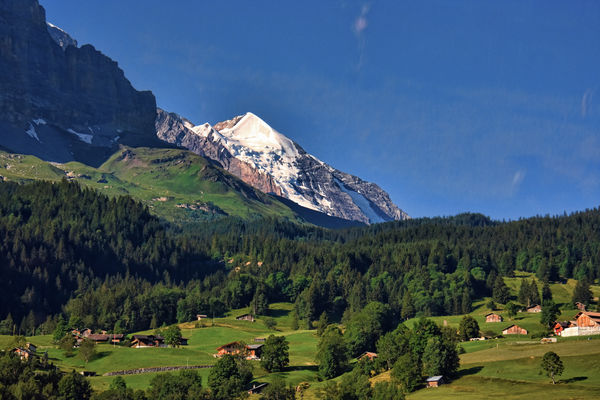
(Download)
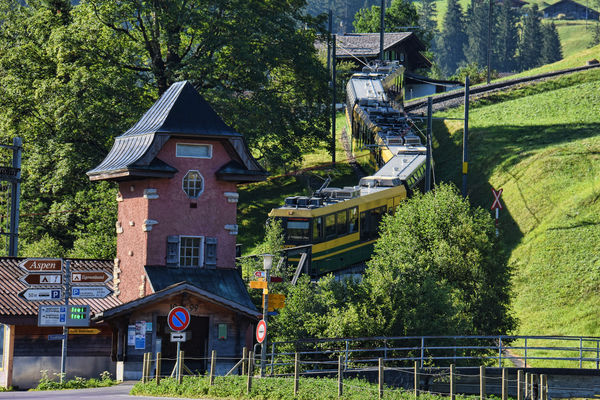
(Download)
The Grund Station
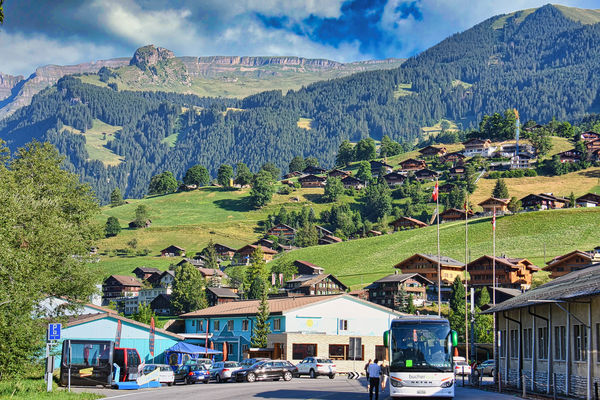
(Download)
Cog Railway tracks
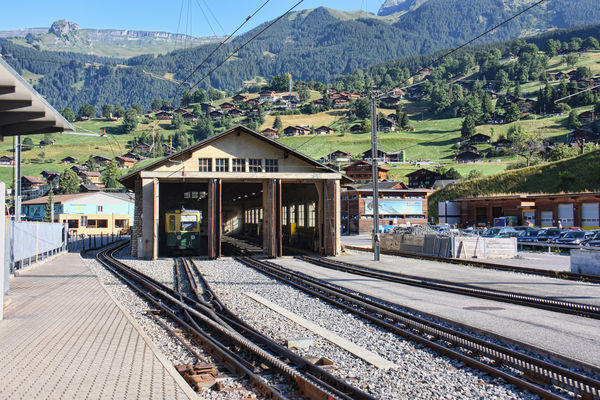
(Download)
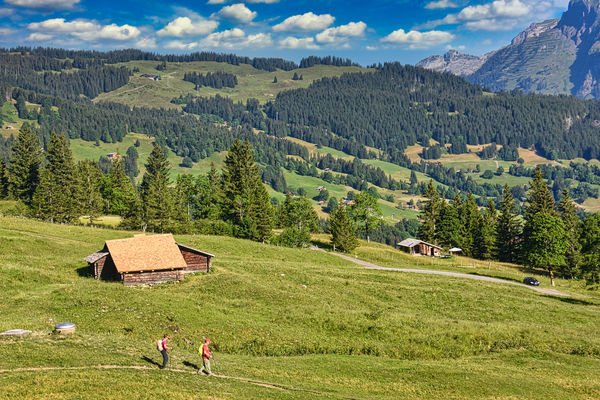
(Download)
Taken from the back of the train on the way up
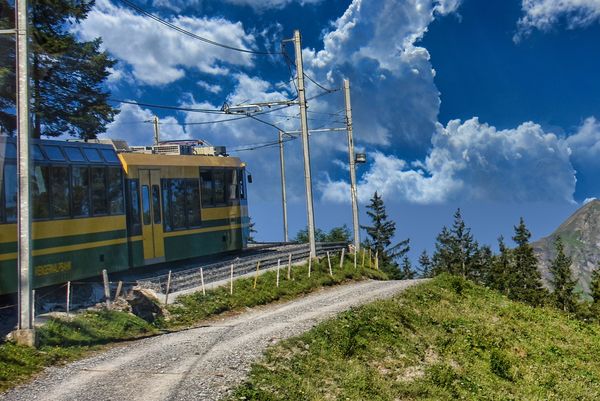
(Download)
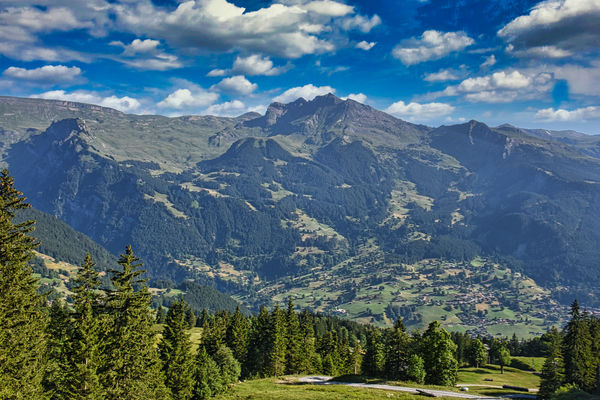
(Download)
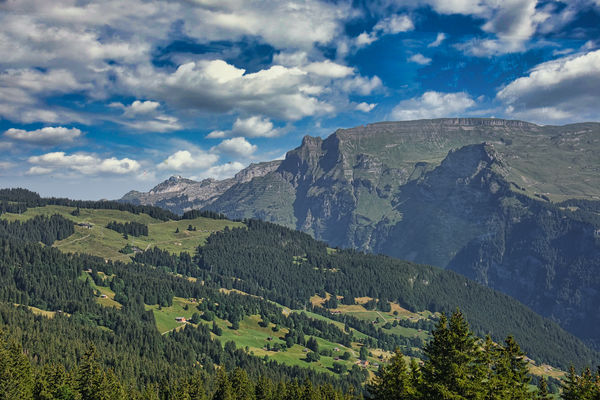
(Download)
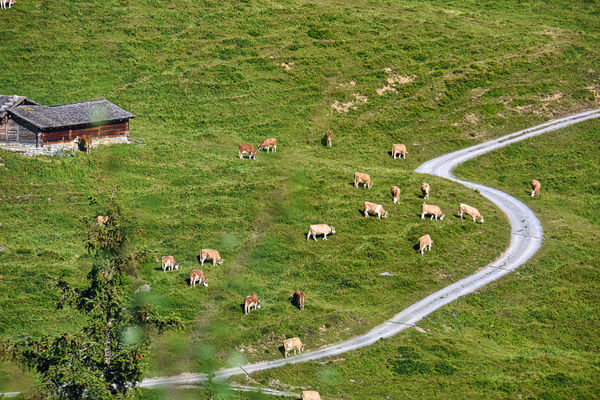
(Download)
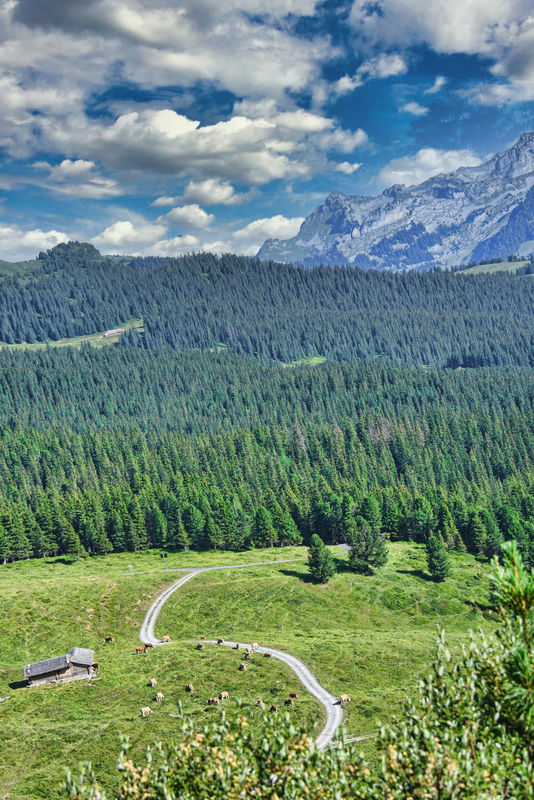
(Download)
Feb 15, 2021 16:39:42 #
Feb 15, 2021 16:51:56 #
srfmhg wrote:
The Jungfraujoch (German: lit. "Jungfrau sadd... (show quote)
Great photos Mark. I am anxiously awaiting the rest of the series.
Feb 15, 2021 16:55:04 #
jliane
Loc: Washington state
Cog railways give me the heebie jeebies but sometimes they must be taken
Feb 15, 2021 17:06:28 #
Beautiful set, Mark! Very interesting to see this without snow. When I was stationed in Europe, the various military ski clubs would rent the hotel and other related buildings at the top for a Thanksgiving weekend ski fest. The Europeans did not start their ski season until Dec.1, so we had the whole place to ourselves.
Feb 15, 2021 17:06:51 #
Feb 15, 2021 17:07:26 #
srfmhg wrote:
The Jungfraujoch (German: lit. "Jungfrau sadd... (show quote)
Spectacular, incredibly beautiful shots
 OMG - what it must be like to live in a place so sublime
OMG - what it must be like to live in a place so sublime 
Feb 15, 2021 17:36:17 #
Merlin1300 wrote:
Excellent Series - Thank You :) :)
Thank you so much for looking Merlin.
Feb 15, 2021 17:37:34 #
DJphoto wrote:
Great photos Mark. I am anxiously awaiting the rest of the series.
Thanks very much Dennis. I'm trying to organize them now. It's fun reliving the trip.
Feb 15, 2021 17:39:40 #
jliane wrote:
Cog railways give me the heebie jeebies but sometimes they must be taken
Thanks for commenting jliane. The cogs actually gave me a sense of security - no rolling backwards!
Feb 15, 2021 17:42:01 #
UTMike wrote:
Beautiful set, Mark! Very interesting to see this without snow. When I was stationed in Europe, the various military ski clubs would rent the hotel and other related buildings at the top for a Thanksgiving weekend ski fest. The Europeans did not start their ski season until Dec.1, so we had the whole place to ourselves.
Thanks Mike. I appreciate your perspective. It must be gorgeous in winter as well. I would have loved to ski there - especially without the crowds!
Feb 15, 2021 17:42:46 #
Feb 15, 2021 17:43:39 #
joecichjr wrote:
Spectacular, incredibly beautiful shots  OMG - what it must be like to live in a place so sublime
OMG - what it must be like to live in a place so sublime 
 OMG - what it must be like to live in a place so sublime
OMG - what it must be like to live in a place so sublime 
Thanks so much for your kind comments Joe.
Feb 15, 2021 18:02:26 #
Feb 15, 2021 18:07:05 #
Cwilson341 wrote:
Beautiful compositions! These are great shots.
Thank you so much Carol. I appreciate the compliments.
If you want to reply, then register here. Registration is free and your account is created instantly, so you can post right away.






